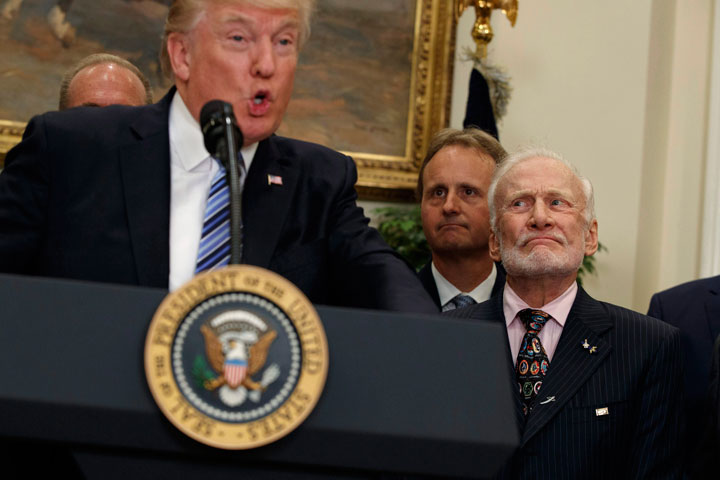Buzz Aldrin’s facial expressions might have hinted at what he was thinking during a speech with Trump last weekend, but the former astronaut didn’t tell reporters that his greatest achievement was not punching the president.

On June 30, U.S. President Donald Trump signed an executive order reviving the National Space Council. Aldrin, the second man on the moon, visibly reacted several times during Trump’s speech, raising his eyebrows and eyeing the president.

Clips of the speech went viral, as did a news story in which Aldrin allegedly said that his greatest achievement was not punching Trump.
The story, published by The Rochdale Herald on June 3 and shared thousands of times on Facebook, made the claim. However, The Rochdale Herald is a satirical publication, as pointed out by Snopes.com.
“The Rochdale Herald is a satirical, spoof, parody commentary on current affairs, and stuff that annoys and amuses us. We make it up and it’s not intended, in any way whatsoever, to be considered factual,” says the site’s “About Us” page.
One thing that probably made the story more believable is that Aldrin actually has punched people in the past – he once famously took a swing at a moon landing denier who called him a liar.
Here’s what else was happening in the world of fake news this week:
- A man accidentally shot himself in the leg after he showed up to protest a group that was reportedly planning to desecrate Confederate graves at Gettysburg, BuzzFeed reports. The man really shot himself, but there was no one actually planning to desecrate graves. There was a post on a Facebook page saying that “Antifa” left-wing protestors were planning to go, which spread on social media despite having dubious origins. Dozens of people showed up to defend the graves – from no one, as it turned out. They were the only ones there.
- A woman inflated several companies’ stock prices by placing fake news articles in various media outlets, court documents unearthed by the Washington Post allege. In one case, the positive articles and social media posts helped to drive up the stock of Galena Biopharma, a pharmaceutical company, by 925 per cent, according to a SEC complaint.
- A photo of a dead man from Pompeii circulated on Twitter – mostly because the pose he was frozen in after the volcanic eruption looked a lot like masturbation. Social media users reacted with glee, making all imaginable jokes about volcanoes and eruptions, though as BuzzFeed and the Daily Dot point out, it’s very unlikely that the man was engaged in that kind of activity at the time of his death. The extreme heat of the blast tended to contort victims’ limbs, explained a volcanologist, leaving them in all sorts of unusual poses.
- Hackers created fake news sites in an attempt to trick reporters covering China into giving away real news sites’ login information, according to a report by Gizmodo based on work by the University of Toronto’s Citizen Lab. The idea was to create a news site that looked just like a real one, like the Epoch Times or China Digital Times, and e-mail a journalist a link to the fake site, saying that they have information that shows their story is wrong. When the journalist clicked the link, a login box would appear, and hackers could steal the reporter’s login credentials if he or she entered them into the page. Citizen Lab found that this scheme was linked to previous malware operations targeting Tibetan journalists, though it couldn’t attribute the phishing campaign to a specific group or state actor.
- Rachel Maddow, a host on MSNBC, said her show was sent what was supposedly a top-secret NSA document that discussed Russia’s involvement in the U.S. election. But, she believes that the document was a “carefully-forged” fake, designed to discredit any news organization that believed it was real and reported on it. In a segment on her show, she warned other news organizations about such hoaxes and the possible consequences of reporting on inauthentic documents.
Read more about how to spot fake news here.
- Life in the forest: How Stanley Park’s longest resident survived a changing landscape
- ‘Love at first sight’: Snow leopard at Toronto Zoo pregnant for 1st time
- Carbon rebate labelling in bank deposits fuelling confusion, minister says
- Buzz kill? Gen Z less interested in coffee than older Canadians, survey shows




Comments